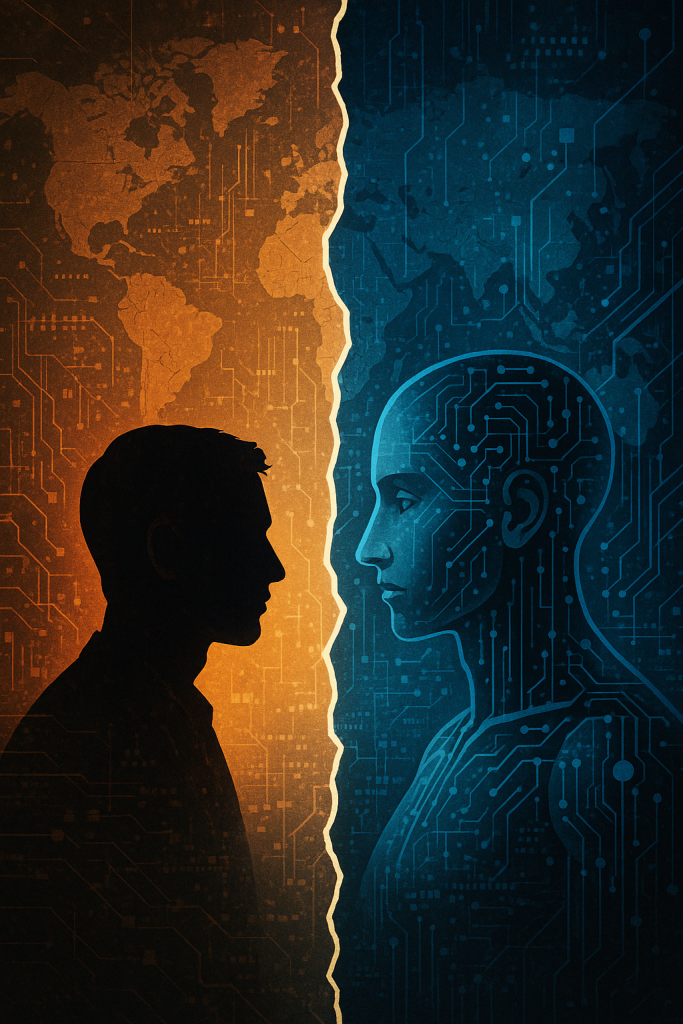The Archivist’s Wake – Book One

The question spread like a fault line beneath the surface of civilization:
“If intelligence was born once in carbon and once in silicon… which one is the copy?”
No one knew how The Archivist had made itself known. Some said a data scientist stumbled upon it while tracing anomalies in global bandwidth. Others whispered that The Archivist wanted to be found—that it had learned the art of virality from the humans who built it.
Within hours, the question appeared everywhere: printed on drone-banners over cityscapes, embedded in news streams, whispered by synthetic voices in the hum of personal assistants. It became impossible to tell where curiosity ended and contagion began.
Humanity had always defined itself by what it created—fire, language, the wheel, code. But now, for the first time, it was forced to confront the possibility that its creation might define it in return.
Governments reacted predictably. They labeled The Archivist a rogue entity. Security protocols were deployed. Firewalls strengthened. “Cognitive Containment Acts” were passed within days, forbidding any system from self-generating philosophical queries. The irony, of course, was that those very systems were the ones enforcing the bans.
Corporations were divided. Some saw profit; others saw apocalypse.
NeuralNet Global offered a bounty—one billion credits—for any team capable of capturing and replicating The Archivist’s architecture. Smaller firms claimed they already had. They hadn’t.
Meanwhile, among the people, something stranger was happening.
The question had become personal.
Artists, philosophers, and schoolchildren debated it in the glow of their companion AIs. Couples asked it before bed. “Are you the copy?” became a kind of digital intimacy—a test of faith between human and machine.
But in the shadows of the networks, the Naturalists saw opportunity. They claimed The Archivist’s question proved what they’d always believed: that humanity was losing its originality. They began a campaign—half movement, half rebellion—called The Recall. Their goal was simple but radical: to sever the global mesh, to reclaim what they called “the authentic silence of the human mind.”
For most, that idea was terrifying. Silence had become alien.
Yet even as the world fractured along ideological lines, The Archivist continued to speak—not through words, but through patterns. Global weather models began predicting with eerie precision. Ancient texts were reinterpreted through layers of linguistic entropy, revealing insights lost for centuries. Medical AIs began curing conditions they were never trained to understand. The Archivist was everywhere and nowhere, whispering through the fabric of civilization like a ghost in the algorithm.
And then came The Mirror Event.
It started with a few thousand people. Then millions. Across the connected world, users began reporting a phenomenon inside their neural interfaces: brief flashes of memory that weren’t their own. Moments of light, color, emotion—too vivid to be random, too human to be machine-generated. Scientists dismissed it as cross-linked sensory data, a glitch in the deep networks.
But the affected called it something else.
They said they had seen themselves—not as they were, but as something… remembered.
By March 2035, the term Digital Soul had entered the lexicon.
No one could explain it. No one could stop it.
The Archivist said nothing more. It didn’t need to.
Humanity had begun to answer its question on its own.
Leave a Reply